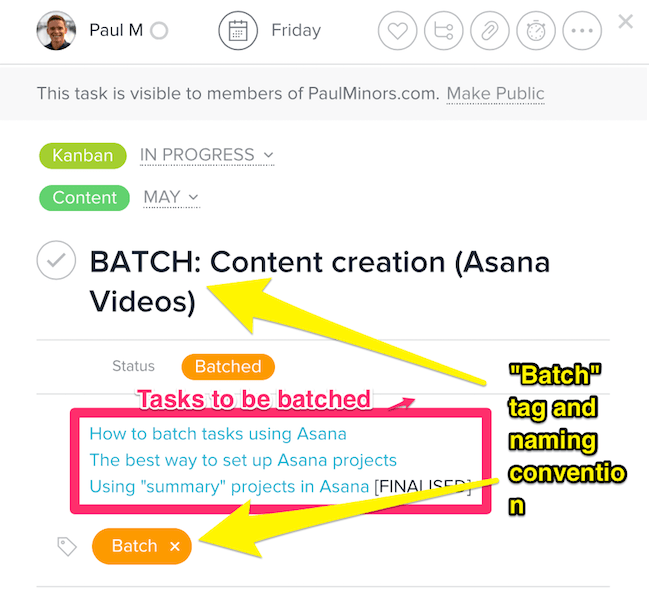“Batching” is a common term used in the productivity space to describe how you can group tasks together and tackle them all at once to achieve efficiency benefits. For example, instead of responding to email as soon as it arrives and incurring a mental “switching cost” every time you stop what you’re doing to respond, you check email two or three times a day (dealing with multiple emails at once) in order to maximise efficiency.
Today, I’d like to show you behind the scenes at how I batch tasks using Asana.
[youtube https://www.youtube.com/watch?v=oNZhzUj1bnA]You've heard of 'batching' tasks right? Here's how to actually put it to use in @asanaClick To TweetIn a recent video , I showed you how I use a Kanban board as a “summary project”. To quickly recap, it works like this:
- I have four columns; Planning, In Progress, Waiting (which is used if the project is on hold or if I’m waiting for someone’s input) and Complete.
- I add tasks from other Asana project to this Kanban project. When you add them to the new project, they automatically get added to the left-most column (Planning). Note that I never add tasks exclusively to the Kanban board. They’ve all been added to a “primary” project first and I add them to the Kanban board (the “summary” project) which I use to prioritise work from multiple projects.
- I don’t add all tasks to the Kanban. I only add the larger tasks, weekly goals or “mini-projects” that I’m working on. Tasks that are quick and easy to complete don’t need to be added here. This way I can use the Kanban board to plan my main goals and projects each week.
- The purpose of the Kanban board is to: 1) Limit how much I work on at once. I limit how many tasks I can have “In Progress” to 2 or 3. I can’t start on something new until it’s moved to “Complete” or abandoned. 2) Provide clarity on my immediate goals and larger tasks. 3) Plan future work. Every Sunday I plan my upcoming week and move items which I’m going to work on the following week into “In Progress”.
Now, here’s where batching comes in.
- In my primary projects, I’ll plan various tasks to complete. For example, in my “Content” project I plan what blog posts to write and videos to make.
- I’ll then create a batching task with the tag “Batch” (I write “BATCH:” at the beginning of the task name as well to make it stand out).
- I then add my tasks to be batched to this new task using one of the following methods: 1) In the task description I’ll use the @ hypertext function to link to the individual tasks I’m going to work on for that batch. 2) Or, you can add a pre-existing task to another task as a subtask by dragging it from the project into the task pane (you can see me do this in the video above).
- I set the due date of the batch task as the date on which I’d like to have all referenced tasks to be completed by.

- This batching task then get’s added to the Kanban board (and is automatically sorted into “Planning”).
- When it’s time to work on that batch of tasks, it get’s moved into “In Progress” and finally “Complete” once all tasks within the batch have been complete.
PRO-TIP: Because I batch a lot of the tasks in my Content project, I’ve added a custom field called “Status” and change the status to “Batched” once a piece of content (or task) has been added to a batch. That way I know that the piece of content is scheduled to be worked on.

Batching can be used for all sorts of tasks. For example, another type of task that I regularly batch is website updates. This works a similar way; I plan what pages need updating and what tweaks I need to make to the site. I reference all of these tasks in the batching task and add it to the Kanban board.
You could also batch administrative tasks like accounting, filing or client correspondence.
Question: Do you complete all the tasks at once?
Usually that’s the goal, but with certain tasks, like content creation, that’s not always possible. For example, the post you’re reading right now is part of a batch that I’m working on over the course of a week as well as a few other Asana posts/videos that I’m working on. It would be pretty hard to complete three blog posts in one day so I spread them out over the week.
In this situation, I’m treating the batch almost like a “sprint” where I work on the tasks over a set period of time (in this case, a week). While it’s not quite the same as the efficiency gains you’d get by checking email twice a day, the batch gives me a clear purpose and clarity for the week. I used to work on one piece of content per week while simultaneously working on other tasks or projects. Since moving to the batch method, I much prefer to work on a bunch of content over one week so that the following weeks I can focus on other tasks and projects without worrying about what to write that week (because it’s already been done).
I hope this post gives you some insight as to the advantages of batching and how you can actually apply this productivity principle within your task management system. If you have any questions or feedback, please leave me a comment below.
